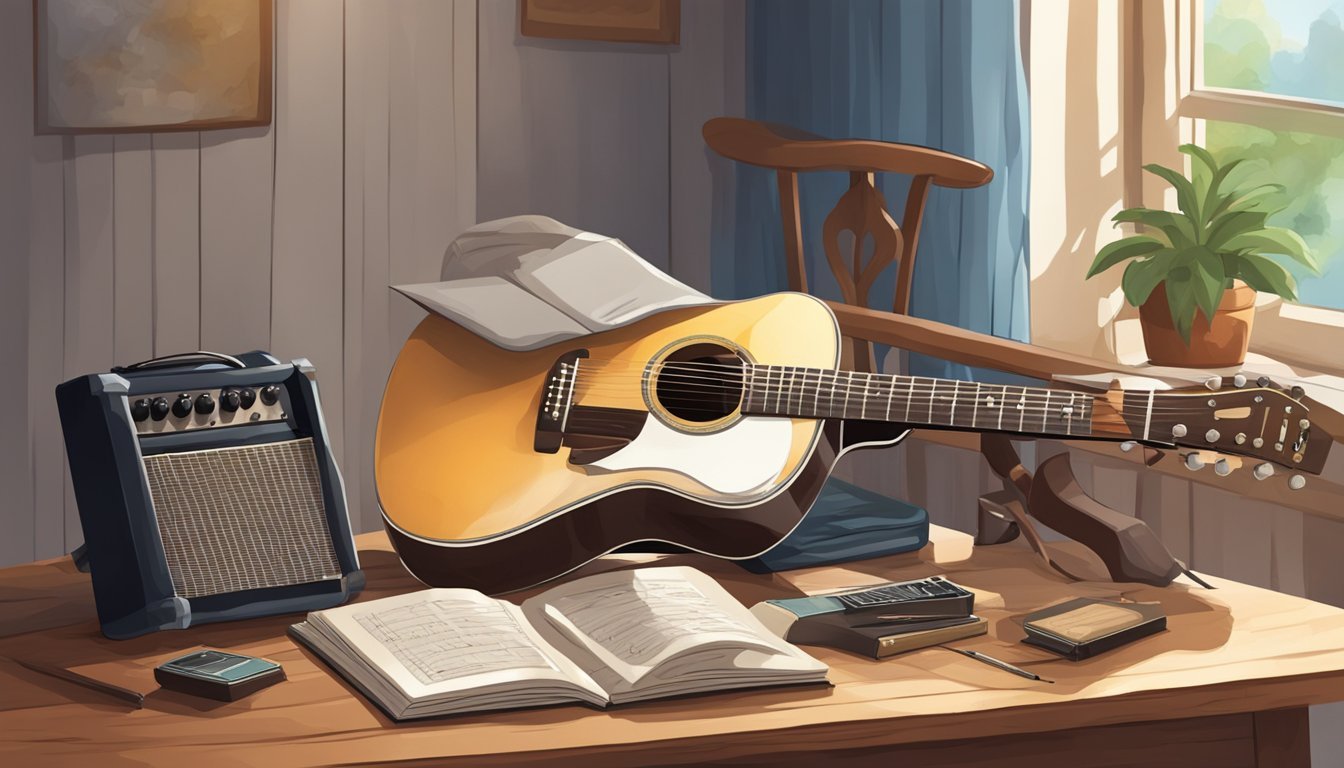Starting to learn guitar can be one of the most rewarding experiences you’ll ever have.
You can quickly progress from a beginner to someone who can strum along to your favorite songs by choosing the right guitar, understanding the basics, and practicing regularly.
Whether you want to play acoustic or electric, getting the right gear and learning some fundamental techniques will set you up for success.

You’ll want to familiarize yourself with your guitar, make sure it’s tuned properly, and develop your strumming and chord skills.
These are essential steps that will help you play confidently and enjoyably.
As you dive into practice, you’ll find that each small achievement builds your skills and encourages you to keep going.
The key to advancing is consistent practice and exploring new techniques as you grow.
With dedication and the right guidance, you’ll be amazed at what you can accomplish.
Let’s get started on your musical journey!
Key Takeaways
- Choosing the right guitar is crucial for beginners.
- Learning the basics helps you play songs quickly.
- Consistent practice leads to skill advancement.
Getting to Know Your Guitar

Understanding your guitar is a crucial first step in your music journey.
This section will cover the important parts of the guitar, the differences between acoustic and electric models, and key guitar brands to consider.
Anatomy of the Guitar
A guitar has several key parts that affect how it sounds and how you play.
Here are the main components:
- Body: This is the large part that influences the sound volume and tone. It comes in different shapes, which can change the sound.
- Neck: This is where you place your fingers to create notes. It connects the body to the headstock.
- Fretboard: Located on the neck, the fretboard has metal strips called frets. Pressing down on the strings between the frets changes the note.
- Headstock: The top part of the guitar holds the tuners, which you use to tune each string.
Familiarizing yourself with these parts will help you understand how to play better.
Acoustic vs. Electric
When choosing a guitar, you’ll likely decide between an acoustic and an electric model.
-
Acoustic Guitars: These guitars produce sound naturally through their hollow body. They are great for singer-songwriters and are typically easier to pick up and play anywhere.
-
Electric Guitars: These use pickups to convert string vibrations into electrical signals. They require an amplifier to produce sound. They offer a wider range of sounds and effects through pedals and settings.
Both types have unique advantages.
Think about what style of music you want to play.
Understanding Guitar Brands
There are several reputable guitar brands out there.
Here are some popular ones you should know:
- Fender: Known for its electric guitars like the Stratocaster and Telecaster, Fender offers great options for new players.
- Gibson: Famous for models like the Les Paul and SG. These guitars are often more expensive but are well-loved for their quality.
- Yamaha: Offers a range of affordable acoustic guitars that are excellent for beginners.
- Martin: Renowned for high-quality acoustic guitars, perfect for those serious about fingerpicking and strumming.
Choosing the right brand can impact your playing experience, so do a little research to find what suits your style.
Fundamentals of Guitar Playing
Getting started with the guitar involves some key basics.
You’ll need to focus on how to hold the instrument, learn some basic chords, and develop your strumming techniques.
Mastering these areas will give you a solid foundation for your guitar playing journey.
Holding the Guitar Properly
First things first, holding your guitar correctly is essential.
Sit down comfortably with the guitar resting on your right leg (if you’re right-handed).
Your back should be straight, and the neck of the guitar should tilt slightly upwards.
Ensure that your left hand can easily reach the fretboard without straining.
When you play, your fingers should press down on the strings close to the fret, not on top of it.
This will help you create clearer sounds.
Remember, with poor posture or grip, your journey may become uncomfortable.
Learning Basic Chords
Once you’re comfortable holding the guitar, it’s time to learn some basic chords.
Start with open chords, which are simple and let you use the open strings.
Some popular ones include C, G, and D.
To practice, look at a chord chart that shows finger placement.
Press down the strings firmly and strum gently with your pick or fingers.
Each chord has its sound, so listen as you play.
Don’t worry if you don’t get it perfect right away.
Keep practicing those transitions between chords!
Developing Strumming Techniques
Strumming is where you can really start to make music.
Use a pick or your fingers to strum across the strings.
It’s best to start slow and build speed as you get comfortable.
Focus on playing downstrokes at first, then mix in upstrokes.
Practice different rhythms and try to keep a steady beat.
Experiment with different patterns.
Good strumming can change the feel of a song.
It’s a vital part of playing and adds a lot to your overall sound.
With practice, you’ll find your style and become more confident with each strum!
Tuning, Techniques, and Maintenance
Getting your guitar ready is key to enjoying your playing experience.
You’ll need to know how to tune your guitar, use a pick correctly, and practice scales to build your skills.
How to Tune Your Guitar
Before playing, tune your guitar.
This ensures your music sounds good.
The most common method is using a guitar tuner.
You can buy a clip-on tuner or download a tuning app on your phone.
For standard tuning, your strings should be tuned to these notes, from the thickest to the thinnest:
- 6th string: E
- 5th string: A
- 4th string: D
- 3rd string: G
- 2nd string: B
- 1st string: E
Pluck each string while watching the tuner.
Adjust the pitch by turning the tuning pegs until you hit the right note.
Consistent tuning goes a long way for better sound!
Understanding Picks and Strumming
Using a guitar pick can change your strumming style.
Hold your pick between your thumb and index finger, with the pointed edge facing down.
This grip helps you to control your strumming better.
When strumming chords, make sure to use a relaxed hand.
Strumming from your wrist rather than your elbow gives you better fluidity.
You can use a simple down-stroke or mix in upstrokes for variety.
Start slow and focus on keeping an even rhythm.
As you get comfortable, try different patterns to spice things up.
Remember, practice is key to getting it right!
Practicing Guitar Scales
Practicing guitar scales will help you become a better player.
A great place to start is the major scale because it’s the foundation for many songs.
Try this simple pattern on the 6th string:
- Play the 5th fret (A)
- 7th fret (B)
- 8th fret (C#)
- Move down to the 5th fret on the next string and continue.
Repeating this helps with finger strength and dexterity.
Aim to practice scales daily for at least 10-15 minutes.
Over time, you’ll notice a big improvement in your playing!
Advancing Your Skills
As you get more comfortable with your guitar, it’s time to step up your game.
This means tackling advanced chords and progressions, exploring different music genres, and creating a solid learning plan to keep you on track.
Playing Advanced Chords and Progressions
Once you’ve mastered the basics, start exploring advanced chords.
These include barre chords and jazz chords, which add depth to your playing.
- Barre Chords: Learn to reposition your fingers to use your index finger as a “bar” across the neck. This allows you to play chords anywhere.
- Jazz Chords: Explore seventh and ninth chords to give your music a richer sound.
Practice transitioning between these chords smoothly.
You can use guitar tabs to find songs that feature these chords, making it easier to apply what you’ve learned.
Exploring Different Music Genres
Don’t limit yourself to just one style.
Each genre offers unique techniques and skills.
Whether it’s rock, jazz, or blues, explore them all!
- Rock: Focus on power chords and riffs. Experiment with palm muting and slides.
- Jazz: Work on improvisation and complex chord progressions. Pay attention to rhythm and swing feel.
Listening to various genres will inspire you and help develop your ear for music.
Try to play along with songs you love; it’s a fun way to learn!
Creating a Learning Plan
A learning plan is essential for steady progress.
It keeps you focused and motivated.
Start by setting specific goals for each week.
- Daily Practice: Aim for 30 minutes a day on various skills—playing chords, picking single notes, and reading guitar tab.
- Weekly Lessons: Consider online guitar lessons to guide you. These often offer structured courses and exercises tailored to your skill level.
- Review Progress: Take time to reflect on what you’ve learned each month. Adjust your goals and keep challenging yourself.
A well-structured learning plan can transform your guitar skills and keep you engaged on your musical journey.
Frequently Asked Questions
When you’re starting to learn guitar, you probably have several questions.
Here are some answers to help guide you as you begin your musical journey.
It’s essential to understand the importance of mastering the fundamentals, as this will lay a solid foundation for your skills.
Many learners find it helpful to focus on learning guitar basics for beginners, such as chord progressions, strumming patterns, and finger placement.
With consistent practice and patience, you’ll soon be able to play simple songs and develop your own style along the way.
What’s the best way for a complete beginner to start learning guitar?
The best way for a beginner is to start with a simple acoustic or electric guitar.
Focus on learning basic chords and strumming patterns.
Taking short sessions daily, even just 15-20 minutes, can be more effective than longer periods less often.
Can I teach myself guitar at home, and if so, how?
Yes, you can definitely teach yourself guitar at home.
Use online tutorials and videos that walk you through techniques.
Books and apps can also provide structured lessons.
Just make sure to practice regularly to build your skills.
What are the essential chords I should learn first on the guitar?
Start with basic chords like E minor, G, C, and D. These chords are used in many popular songs.
Practicing these will help you play along with music quickly and build your confidence.
Is it possible to learn guitar effectively as an adult?
Absolutely! Many adults learn guitar and find it very rewarding.
Your life experience can actually help you learn faster.
Stay patient, and don’t rush the process.
How much practice time do I really need each day to make progress?
Aim for 15-30 minutes of practice each day.
Consistent, focused practice is more beneficial than longer, sporadic sessions.
This helps your fingers build strength and dexterity over time.
What resources are available for learning guitar for free?
Plenty of free resources are available online.
Websites like YouTube offer countless tutorial videos.
Apps like Yousician and various guitar forums also provide tips and lessons at no cost.

